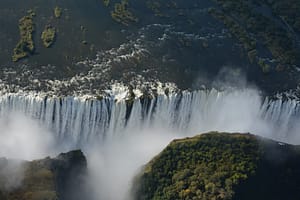During his 1852–56 journey from the upper Zambezi to the mouth of the river, Livingstone had been told about the falls before he reached them from upriver on 17 November 1855 and was paddled across to a small island that now bears the name Livingstone Island on the Zambian half of the river.
Livingstone had previously been impressed by the Ngonye Falls further upstream, but was astounded with the new find, and gave them their English name in honour of Queen Victoria.
He spent the night on Kalai Island a few kilometers upstream of the Falls, having come down river by foot, and the next morning he was paddled out by the local villagers in a small canoe to approach the thundering smoke. He landed on the biggest island on the lip of the falls, now called Livingstone Island and from there obtained his first view of the Falls.
David Livingstone was obviously not the first person to see the Victoria Falls, although he is always credited as having discovered it. In 1860, Livingstone returned to the area and made a detailed study of the falls with John Kirk. Other early European visitors included Portuguese explorer Serpa Pinto, Czech explorer Emil Holub, who made the first detailed plan of the falls and its surroundings in 1875 and British artist Thomas Baines, who executed some of the earliest paintings of the falls.
European settlement of the Victoria Falls area started around 1900 in response to the desire of Cecil Rhodes’ British South Africa Company for mineral rights and imperial rule north of the Zambezi, and the exploitation of other natural resources such as timber forests north-east of the falls, and ivory and animal skins. Rhodes’ vision of a Cape-Cairo railway drove plans for the first bridge across the Zambezi and he insisted it be built where the spray from the falls would fall on passing trains, so the site at the Second Gorge was chosen.
The falls became an increasingly popular attraction during British colonial rule of Northern Rhodesia (Zambia) and Southern Rhodesia (Zimbabwe), with the town of Victoria Falls on the Southern side, becoming the main tourist centre.
In 1989 Victoria Falls was inscribed as a World Heritage Site. The United Nations Educational, Scientific and Cultural Organization (UNESCO) seek to encourage the identification, protection and preservation of cultural and natural heritage around the world considered to be of outstanding value to humanity. The falls also enjoyed the position of one of the seven natural wonders of the world for many years.

